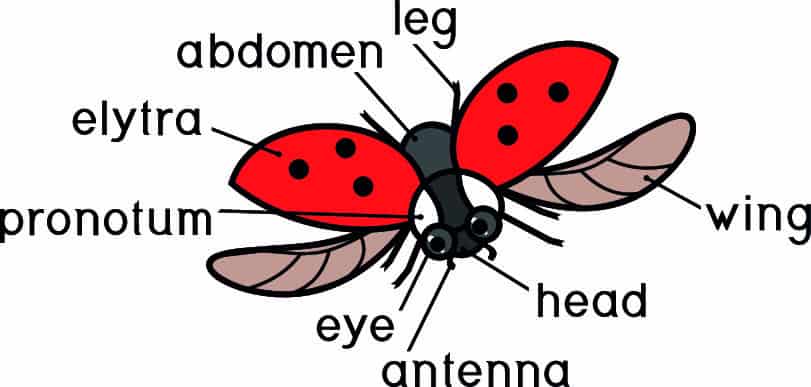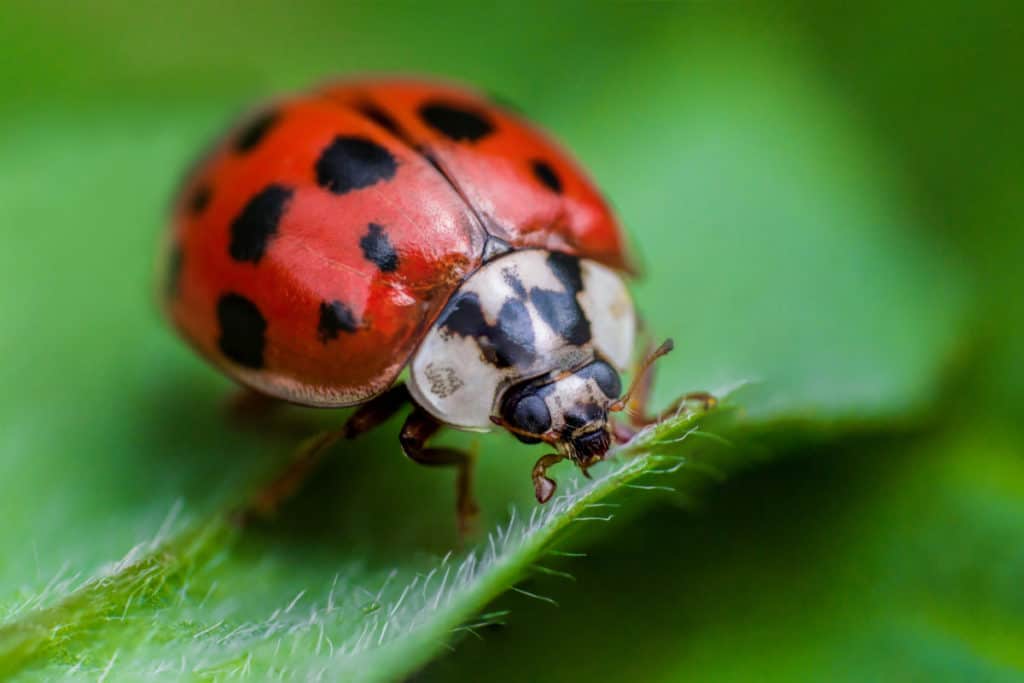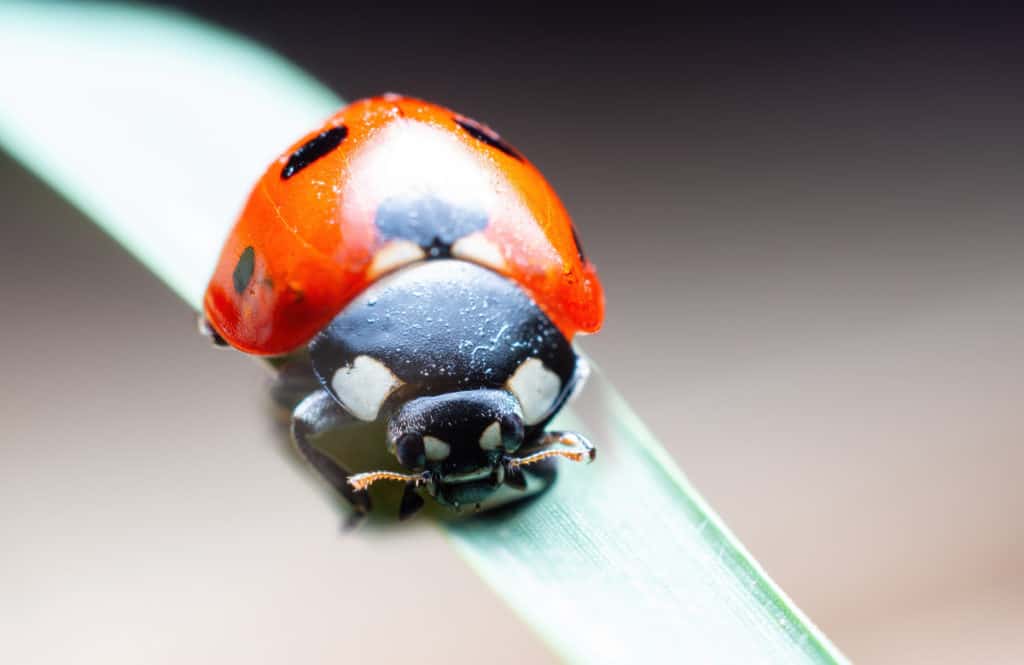Ladybug, ladybird, ladybeetle. Whatever you call them, it’s always a joy to spot one of these adorable creatures in your garden.
But have you ever looked at one closely? Ever wonder how they see the world?
Like most insects, ladybugs have two compound eyes. They can’t see colors but can see different directions at once. Their eyes lack night vision, and things are apparent only when they are near them. Instead, they can smell, touch, and feel their surroundings with their antennae very well.
But do they see things the way we do? What can and what can’t they see?
Read on to find out more about how these little creatures see and sense the world!
Anatomy of a Ladybug
Like all insects, ladybirds have three main body parts: head, thorax, and abdomen. They have an oval-shaped body with six legs, two wings, two antennae, and two eyes. Most ladybugs are about 4-8 mm long.

The beloved critter has a round and thin head, featuring its mouth, eyes, and antennae. An organ right behind the head, called the pronotum, makes the head look round and big, and it protects the head in dangerous situations.
The thorax is where the legs, wings, and elytra come together. The elytra or the color on the wing covers is basically what makes the ladybeetle adorable because of their bright colors red or orange color and black spots. They act as protective shells over the ladybug’s fragile wings.
Finally, the abdomen holds the ladybug’s internal organs, such as the digestive system, reproductive organs, and the musky, unpleasant gel they release when they sense danger.
Eyes of a Ladybug
Ladybugs have two compound eyes, which means they can see in all directions and recognize movements.

This ability is extremely helpful since ladybugs can’t turn their head. The compound eyes let ladybugs perceive different degrees of light intensity. However, they only see in black, white, and grey.
Ladybugs are nearsighted, which means they can only see things clearly when something is near them.
Being nearsighted and seeing in grey shades might seem disappointing, but ladybugs can see in most directions. They can detect movements much more accurately than we do. This helps them react to undesired changes. For example, if they’re flying and the wind changes direction; they can quickly recognize the change and adjust to it.
In general, insects’ visual range is less than 100 feet, whereas this number goes to 2 miles or more for humans.
How Do Ladybug Eyes Function?
Almost all insects have compound eyes as a visual organ made of thousands of ommatidia. Ommatidia are independent photoreception units. They consist of the cornea, lens, and photoreceptor cells that recognize brightness and color. If the eye has more ommatidia, the image’s quality is more, and the insect can see more details.
Most insects, including ladybugs, can only sense light and dark. Only a few species, like bees, see a broad spectrum of colors including ultraviolet light which humans can’t see.
The image perceived by the compound eye is a combination of many inputs from all ommatidia taken from different directions. These inputs are like mosaics, which form a total image together.
So they cover a vast view angle, and they can detect fast movements. This way, ladybugs can quickly hide from predators like birds.
However, the image compound eyes produce has a low resolution compared to a simple eye. Suppose an insect and a human look at the same object; the human sees more details because the eye’s acuity is about 100 times better.
Some insects have more than two eyes, and some have a combination of compound and simple eyes. For example, bees have five eyes: three simple and two compound ones.
How Do Ladybugs See at Night?
Ladybugs don’t have night vision because they don’t have an eye part called tapetum lucidum—a biological reflector system in the eyes of vertebrates. It’s a mirror-like layer in the eye that reflects light outward and makes it possible to see things in the dark.
However, the absence of a tapetum isn’t a problem for ladybugs because they sleep at night. Ladybugs are active during the daytime because they can use their eyes to hunt for food. But during the night, they search for a shelter to rest.
They enter a stable state (stasis), where they stop moving. Still, the digestive system and other physical functions continue to operate. This state lasts until morning when the sun comes up and warms the ladybugs.
Do Ladybugs Sleep With Their Closed Eyes?
Ladybugs sleep at night, but they don’t close their eyes or fall asleep the way we do. They rest while they stay still and unresponsive for hours. They keep their legs under the shell and their head inside the pronotum to be safe.

Using the Antennae to Enhance Vision
Like most insects, ladybugs use their antennae to help them sense their environment and communicate. In this sense, the antennae act as a second set of eyes.
So, poor eyesight isn’t a big deal for ladybugs because their antennae help them survive in the environment.
The antennae also help them smell, taste, and feel their surroundings. That’s why they’re often called feelers. Insects, in general, smell food from long distances just with the pair of antennae on their heads. They can also use them to touch objects, sense hot and cold, listen to sounds, and feel the air movement.
Can Poor Eyesight Put Ladybugs in Danger?
Ladybugs are prey to birds, small mammals, and other insects, but they have an effective defense system.
First of all, the bright red color on the elytra is a warning to predators. It says: “I’m toxic, and I taste awful.” This biological system is called aposematism.
Moreover, ladybugs have a technique called “playing dead” to fool the predators. They don’t move or even sometimes turn on their backs to play dead. They also fold their legs and release fake blood, which smells bad.
Finally, if a hunter attacks, they release a poisonous, bad-tasting, sticky gel through their leg joints to defend themselves.
So, despite their low vision, they’re not entirely defenseless, as these cute critters are far from being naïve.
If you are interested we do have an entire article that dives into this topic of how poisonous ladybugs are. If you would like to check it out the article is called, Are Ladybugs Poisonous?
Do Ladybugs Use Their Eyes to Look for Food?
Not really. Ladybugs locate food by sensing it with their antennae. They munch on aphids, small bugs, and soft scales. Psyllids, whiteflies, and other insects are also a part of ladybugs’ diet. They can smell their meal much better than we do, so who needs eyes!

This topic of what ladybugs like to eat is very interesting. They can be very savage. If you want to know more we have a comprehensive article dedicated to this topic. Check it out if you like the article is called, What Do Ladybugs Eat?
Do Female and Male Ladybugs Have Different Eyes?
The head part, including the eyes, isn’t different in male and female ladybugs.
The differences are just under the abdomen—i.e., the reproductive organs. However, the average person can’t easily tell them apart. The main difference is that females are usually bigger than males.
Entomologists generally use a microscope to make the distinction. Some people think all ladybugs are female because of the name ladybug, but they have both genders for mating.
Do Different Ladybug Species Have Different Eyes?
There are about 5000 species of ladybugs around the world, with different colors, sizes, and shapes. Some examples include the Asian lady beetle, cardinal ladybird, and convergent lady beetle.
Their looks vary, and their appetite isn’t the same. They also live in many places with different climates. Despite these differences, there’s little evidence to suggest that ladybug species vary in terms of eye structure. Nevertheless, research on the topic seems to be scarce.
The Wrap Up
Ladybugs have two compound eyes, which make them able to see in different directions. The world is black and white to the beloved beetle because they can’t see colors. They can see something clearly only when it’s near them, and they can’t see at night at all.
However, these shortcomings don’t pose a big problem because their antennae help them smell, touch, and feel things. They also have different techniques, such as playing dead and aposematism, to protect them from danger.
Sources
● Home Science Tools: Learn about Ladybugs
